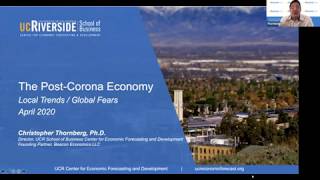
Compared to what many others are predicting, a new presentation from prominent economist Christopher Thornberg delivers a more optimistic assessment of the long-term economic impacts that could result from the worldwide COVID-19 crisis. In the video presentation, released today by the UCR School of Business Center for Economic Forecasting and Development, Thornberg argues that many of the most dire predictions of economic armageddon are hyperbolic, although he acknowledges a number of serious wild card issues that could tip things downward.
While underscoring the uncertainty surrounding the timeline for activity reopening, Thornberg gave a baseline forecast for the U.S. economy that has GDP growth at 0% in the 1st quarter and -25% in the 2nd, after which the 3rd quarter will surge to 20% and the 4th quarter settle down to 5%. This is based, however, on significant economic activity resuming by the end of May.
“If the extraordinary health mandates that have been put into place do indeed control the spread of the virus over the next four to six weeks – and we are seeing that happen in other countries and in parts of the United States – then we expect things to come roaring back in the 3rd quarter with only mild long-term damage,” said Thornberg, director of the UCR Business School’s Center for Economic Forecasting. “Part of our optimism centers around the fact that this unprecedented crisis is not hitting a fragile economy, but a sturdy one that was fundamentally sound when the problem started.”
Thornberg’s presentation includes the following key points:
• The cure is definitely NOT worse than the disease. If the U.S. or global economy has to go through a second viral outbreak that approximates the current one, the damage will likely be far greater. Activity should not be reopened until health experts indicate it is safe to do so.
• The possible long-run damage caused by the halt in economic activity ranges from mild (similar to many natural disaster scenarios where short-run impacts are severe but there is a large ‘bounce’ during recovery/rebuilding) to structurally serious (if the virus is not contained for a long time).
• The Federal government’s intervention is extremely aggressive and while there is ‘pork’ in the stimulus, it will help stabilize U.S. households and businesses in the short term.
• The fiscal crisis that Thornberg has been warning about for years is now coming into frightening focus. This might be a year when the Federal government borrows an unprecedented $3 to $4 trillion. If that happens, the nation will likely be about five to six years away from a massive fiscal emergency.
• Thornberg points out how expensive it is to permanently fire employees and argues that most businesses, acting in their own self-interest, will reserve that as a last possible option. Most jobs affected during the crisis are being deferred, not eliminated.
• Driven by stock market volatility, the Federal Reserve has gone nuclear in attempting to shore up credit markets even though we are yet to see any credit market disruption.
• The way U.S. financial markets have come to operate was broken prior to the pandemic with the financial system a regular source of crisis in itself. Thornberg says “the U.S. financial system is no longer a shock absorber for the nation as it should be, it now causes shocks on its own.” The volatility that has become standard in this broken system has never been so high as in recent weeks. Regulators need to correct these manipulated imbalances (related to issues such as high speed trading and dark pools) as soon as is feasible and return the markets to the way they are supposed to work.
View the full presentation and accompanying PowerPoint slides here.




